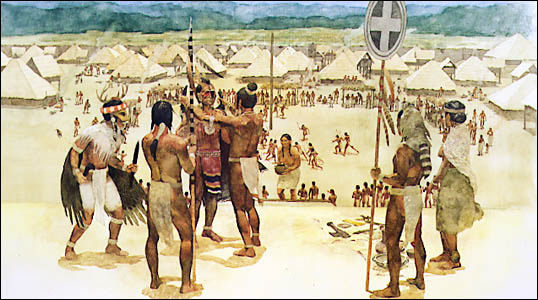"The Cherokee-Osage wars of
the early nineteenth century are a matter of record and I have
not falsified the record. The historical events happened as related,
and all letters and documents and speeches quoted are from the
archives . . . At Three Forks, in 1821, this is the way it was.
"It was not, however, until 1816,
when the western Cherokees, augmented by their relatives in the
east and recruits from the Koasati, Tonkawa and Comanche tribes,
and eleven white men, to the number of six hundred warriors,
marched into Osage country and fell upon Claymore's village in
a raid which turned into a massacre, that the government acted.
Almost the first duty Major Bradford found facing him was that
of making a study of this raid and trying to excerpt from the
various stories about it the truth. Eventually he could write
to Governor Clark: 'The friendly letter they wrote to the Osages
when they got near their town, inviting them to come to the lick
(to make a treaty assuring them only ten or fifteen of them had
come to make a treaty of peace) was most dastardly. After getting
an Osage chief to come down and smoke with them in friendship,
to fall on him a lone man, and murder him is a species of barbarity
and treachery unknown among Indians of the most uncivilized kind;
this also under the eye of their chiefs Tulentuskey and Tuckatochee,
The Black Fox and The Bowls -- the latter gave him the first
stroke, immediately aided by several whites, Isaacs, the Chissoms
and Williams. Isaacs and King, the whites among them,
is more savage than the Cherokees themselves. The Choctaws and
Chickasaws that is incorporated with the Cherokees together with
the whites that live among them is a set of the most abandoned
characters ever disgraced a gallows.' "
"Major Bradford was the commanding
officer at Ft. Smith (now Arkansas) who was charged with keeping
the peace between the Cherokee and the Osage (whom the Cherokee
had displaced when the Cherokee were asked to move from northeast
Arkansas and southeast Missouri by the United States Government)
. . ."
|






